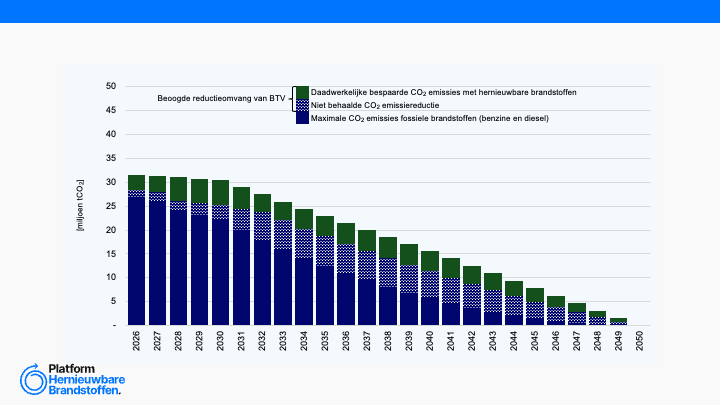Filter opties

Electric mobility
Analyse brandstoftransitieverplichting
Het Platform heeft een analyse uitgevoerd waarin we gekeken hebben naar de effecten van de brandstoftransitieverplichting als we de huidige doelen lineair doortrekken naar 100% hernieuwbaar in 2050. Hieruit blijkt dat we de beoogde emissiedoelen niet behalen zonder een aanpassing

Europa kan zelfvoorzienend zijn met eigen hernieuwbare energie en biogrondstoffen
Het is mogelijk om met Europese hernieuwbare energiebronnen en biogrondstoffen te voorzien in de vraag in 2040, laat CE Delft zien in Rapport "Energy sources and demand in 2040"

PHB: Factsheet ontwikkeling van het elektrisch wagenpark tot 2030 | 2022
Deze factsheet werd eerder gepubliceerd bij deze campagne van Platform Hernieuwbare Brandstoffen: "Elektrisch Rijden Groeit Hard". Download hem hier.
.png)
Why pay attention to ETS II?
A short blog post on the new ETS for buildings and transport in the EU, warning that volumes for renewable fuels may need to increase to double the currently mandated volumes (per RED) by 2028.
Job Barnhoorn (REG): "We kunnen niet wachten tot emissievrije technologieën een schaalbare impact hebben."
Job Barnhoorn van platformlid Renewable Energy Group en co-voorzitter van de Nederlandse Biodiesel uit Afval Alliantie (NBAA) pleit voor hogere doelen voor hernieuwbare brandstoffen.
TNO/SmartPort: The potential of e-fuels for heavy duty road transport in the Netherlands | 2023
TNO (partner in the SmartPort Rotterdam initiative) examined the different options for realising more sustainable heavy duty road transport in the Netherlands. The report mainly focuses on e-fuels, but covers the benefits and drawbacks of BEVs and biofuels as well.

Scania: The Pathways Study: Achieving fossil-free commercial transport by 2050 | 2018
Achieving a fossil-free commercial transport system in the timeframe of the Paris Agreement target is not only possible, but also financially attractive from a societal perspective. This is the key conclusion of The Pathways Study initiated by Scania.

KiM: Energieketens voor CO2-neutrale mobiliteit–Efficiëntie, kosten en ruimtegebruik in beeld
Het Kennisinstituut voor de Mobiliteit (KiM) onderzocht vier verschillende opties voor CO2-neutrale mobiliteit: elektriciteit, waterstof, synfuels en biobrandstoffen; met daarbij kijkend naar de complete energieketens: van productie tot gebruik in het voertuig.

PHB: Reactie op Kamerbrief Min. I&W Voortgang Duurzaam Vervoer | 2023
Commentaar van het Platform op de kamerbrief van het Ministerie van Infrastructuur en Waterstaat van 13 januari 2023, waarin een update gegeven wordt van de stand van zaken met betrekking tot de verduurzaming van de Nederlandse mobiliteitssector.
Eerste Reactie Platform Hernieuwbare Brandstoffen op KEV22 van PBL
In een reactie op de Klimaat- en Energieverkenning '22 van het Planbureau voor de Leefomgeving toont Eric van den Heuvel van Platform Hernieuwbare Brandstoffen aan dat bij huidig en voorgenomen beleid het aandeel auto's met een verbrandingsmotor nauwelijks afneemt.

SEI: Accelerating to zero: Speeding up the decarbonization of heavy-duty vehicles in the EU | 2021
12-07-2022 | This 2021 report by Stockholm Environment Institute analyses technology and emissions developments in the heavy-duty road transport sector.
PHB: Error in the calculation of the greenhouse gas intensity of electricity in FQD and RED | 2021
21-12-2021 | An error in the calculation of the greenhouse gas intensity of electricity in the Fuel Quality Directive (FQD) and in the amended Renewable Energy Directive (RED2) will cause a deviation between administrative GHG-emission reductions and real emissions.
DNV - Energy Transition Outlook 2021: Technology Progress Report (2021)
DNV has recently published their Energy Transition Outlook (2021) in which they focus on how key energy transition technologies will develop, compete, and interact in the coming five years.

Sustainable and Smart Mobility Strategy
In this strategy document the European Commission shares her vision and action plan of how the mobility sector should take shape in the following decades.

The greenhouse gas emissions of an electrified vehicle combined with renewable fuels: Life cycle assessment and policy implications
This research publication by Andersson and Börjesson presents a life cycle assessment on current vehicle’s greenhouse gas impact when using a combination of electrification and renewable fuels.

The role of renewable transport fuels in decarbonizing road transport
The core objective of this project was the assessment of the possible evolution of road transport sectors within five individual countries (Finland, Sweden, Germany, USA and Brazil).

Volgens KEV2020 te weinig groei in aandeel hernieuwbare brandstoffen in transport
30-10-2020 | Het Planbureau voor de Leefomgeving (PBL) publiceerde op 30 oktober 2020 de Klimaat- en Energieverkenning (KEV) voor 2020. In het rapport stelt PBL dat de klimaatdoelstelling voor 2030 niet gehaald wordt.


